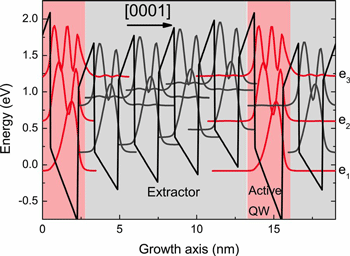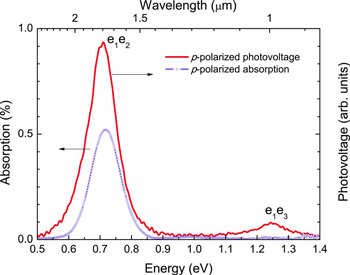- News
17 May 2012
Nitride quantum cascade detector responds to record short-wavelength IR
Researchers in France and Switzerland have used nitride semiconductor quantum cascade (QC) structures to detect short-wavelength infrared light [S. Sakr et al, Appl. Phys. Lett., vol100, p181103, 2012]. The team was based variously at University of Paris-Sud (UPS) and Ecole Polytechnique Fédérale de Lausanne (EPFL).
QC structures have been widely studied for laser emission and detection in the far- and mid-infrared spectral regions, using arsenide- and phosphide-based semiconductors. The nitride semiconductor structure enabled detection of the shortest wavelength so far of 1μm for QC detectors. This raises the possibility of use with infrared fiber-optic communication systems.
QC detectors (QCDs) have advantages over other techniques such as low noise at zero bias due to the absence of dark current. Further attractions include high-frequency operation due to short electron transit times and easy tuning of detected wavelengths with quantum well thickness.
 Figure 1: Conduction band diagram of one period of QCD with adjacent active QW. The red and grey regions correspond to active QW and extractor stages, respectively.
Figure 1: Conduction band diagram of one period of QCD with adjacent active QW. The red and grey regions correspond to active QW and extractor stages, respectively.
The UPS/EPFL device contained active quantum well (QW) regions consisting of seven monolayers (1ML = 0.26nm) of n-GaN. These QWs, separated by extractor regions (Figure 1) composed of undoped 4x AlN/Al0.3Ga0.7N (4ML/6ML), were grown in a 50-period cascade structure.
This structure was simulated to have three bound states
(e1, e2, e3) between which transitions could be excited by illumination with infrared. The energies for intersubband (ISB) transitions from the ground state (e1) were 0.7eV (e2) and 1.3eV (e3). The extractor structures were tuned to encourage transfer to the next period via scattering with the GaN longitudinal optical phonon of energy 92meV.
The QC structure was sandwiched between n-Al0.3Ga0.7N cladding layers. The material was grown on AlN on c-sapphire templates using ammonia-source molecular beam epitaxy (MBE). The active-region growth temperature was 800°C.
For electro-optic measurements, the material was formed into 700μm x 700μm mesas by etching; then titanium/aluminum/titanium/gold top and bottom contacts were applied. The center of the top layer was unmetallized to allow illumination into the device.
The current-voltage curves of the devices were more symmetric than expected, given the polarization electric field in the structure (giving the triangular wells/barriers in Figure 1 simulation), suggesting that perhaps dislocations were creating parasitic conduction channels. The polarization electric field was part of the design of the device, allowing transitions to the second excited state (e3) through symmetry breaking.
 Figure 2: Absorption (solid lines with a square) and photovoltage spectra under p-polarization.
Figure 2: Absorption (solid lines with a square) and photovoltage spectra under p-polarization.
The photovoltage and absorption spectra were measured in a Fourier transform infrared (FTIR) spectrometer (Figure 2). The absorption of the active region was measured in scans across facets at 45° to the substrate. Both photovoltage and absorption spectra show peaks at 1.7μm (0.71eV). The 1μm (1.25eV) peak was only seen in the photovoltage measurement.
The peaks were only seen with light that was p-polarized (field direction parallel to plane of incidence) and not with light that was s-polarized (perpendicular). This is taken as a “clear indication that they originate from ISB transitions”.
The researchers comment: “It should be noted that the 1μm peak detection wavelength is the shortest value ever reported for an ISB detector.”
The response at 77K was 1.6x that at room temperature. The 1.7μm peak had a response of 0.1mA/W at 77K; the value for the 1μm peak was 0.008mA/W.
The researchers believe the response could be improved by reducing the material defects in the active region. Longer-wavelength devices could be produced with lower Al-content alloys.
Quantum cascade detectors Short-wavelength IR GaN AlN MBE
The author Mike Cooke is a freelance technology journalist who has worked in the semiconductor and advanced technology sectors since 1997.
